Research Status on the Application Technology of Early Age Carbon Dioxide Curing
Abstract
1. Introduction
2. Early Age Carbon Dioxide Curing Technology and Its Reaction Mechanism
3. Factors Influencing the Carbonation Effect of Early Age Carbon-Dioxide-Cured Concrete
3.1. Carbonation Time
3.2. CO2 Pressure
3.3. CO2 Concentration
3.4. Relative Humidity
3.5. Temperature
3.6. Active Dopants
3.7. Water-to-Glue Ratio and Water Content
4. Effect of CO2 Curing on the Performance of Concrete
4.1. Volumetric Stability
4.2. Compressive Strength
4.3. Durable Performance
5. Theoretical and Numerical Modeling of Early Age Carbon-Dioxide-Cured Concrete Technology
6. Prospects for CO2 in Cementitious Materials
6.1. Precast Concrete
6.2. Cast-in-Place Concrete
6.3. Recycled Concrete
6.4. Fiber-Reinforced Concrete
7. Conclusions and Outlook
Author Contributions
Funding
Data Availability Statement
Conflicts of Interest
References
- Ding, M.R. Analysis of the current situation of carbon emissions in the cement industry and exploration of key paths for emission reduction. China Cem. 2021, 7, 46–49. [Google Scholar]
- Martín, D.; Flores-Alés, V.; Aparicio, P. Proposed methodology to evaluate CO2 capture using construction and demolition waste. Minerals 2019, 9, 612. [Google Scholar] [CrossRef]
- Habert, G.; Arribe, D.; Dehove, T.; Espinasse, L.; Roy, R.L. Reducing environmental impact by increasing the strength of concrete: Quantification of the improvement to concrete bridges. J. Clean. Prod. 2012, 35, 250–262. [Google Scholar] [CrossRef]
- Shen, W.; Cao, L.; Li, Q.; Wen, Z.; Wang, J.; Liu, Y.; Dong, R.; Tan, Y.; Chen, R. Is magnesia cement low carbon? Life cycle carbon footprint comparing with Portland cement. J. Clean. Prod. 2016, 131, 20–27. [Google Scholar] [CrossRef]
- Scrivener, K.; Avet, F.; Maraghechi, H.; Zunino, F.; Ston, J.; Hanpongpun, W.; Favier, A. Impacting factors and properties of limestone calcined clay cements (LC3). Green Mater. 2019, 07, 3–14. [Google Scholar] [CrossRef]
- Long, Y.L.; Zeng, L. A refined model for local buckling of rectangular CFST columns with binding bars. Thin-Walled Struct. 2018, 132, 431–441. [Google Scholar] [CrossRef]
- Long, Y.L.; Zeng, L.; Gardner, L.; Wadee, M.A. A new model for calculating the elastic local buckling stress of steel plates in square CFST columns. Thin-Walled Struct. 2022, 171, 108756. [Google Scholar] [CrossRef]
- Liao, J.; Zeng, J.J.; Long, Y.L.; Cai, J.; Ouyang, Y. Behavior of square and rectangular concrete-filled steel tube (CFST) columns with horizontal reinforcing bars under eccentric compression. Eng. Struct. 2022, 271, 114899. [Google Scholar] [CrossRef]
- Long, Y.L.; Wan, J.; Cai, J. Theoretical study on local buckling of rectangular CFT columns under eccentric compression. J. Constr. Steel Res. 2016, 120, 70–80. [Google Scholar] [CrossRef]
- Cai, J.; Long, Y. Local buckling of steel plates in rectangular CFT columns with binding bars. J. Constr. Steel Res. 2009, 65, 965–972. [Google Scholar] [CrossRef]
- Zeng, J.J.; Zheng, Y.Z.; Long, Y.L. Axial compressive behavior of FRP-concrete-steel double skin tubular columns with a rib-stiffened Q690 steel tube and ultra-high strength concrete. Compos. Struct. 2021, 268, 113912. [Google Scholar] [CrossRef]
- Zhang, Z.; Ren, X.; Niu, Q.; Zhang, Y.; Zhao, B. Durability degradation simulation of RC structure based on gamma process considering two-dimensional chloride diffusion and life probabilistic prediction. Structures 2022, 48, 159–171. [Google Scholar] [CrossRef]
- Zhang, Z.; Niu, Q.; Liu, X.; Zhang, Y.; Zhao, T.; Liu, M. Durability life prediction of reinforced concrete structure corroded by chlorine based on the Gamma process. ASCE-ASME J. Risk Uncertain. Eng. Syst. Part A Civ. Eng. 2021, 7, 04021061. [Google Scholar] [CrossRef]
- Zhang, Z.; Paul, C.P.; Panda, B.; Huang, Y.; Garg, A.; Zhang, Y.; Garg, A.; Zhang, W. Assessment of flexural and splitting strength of steel fiber reinforced concrete using automated neural network search. Adv. Concr. Constr. 2020, 10, 81–92. [Google Scholar]
- Nicholas, L.; Ling, T.-C.; Pan, S.-Y. Towards carbon-neutral construction materials: Carbonation of cement-based materials and the future perspective. J. Build. Eng. 2020, 28, 101062. [Google Scholar]
- Zhan, B.J.; Xuan, D.X.; Poon, C.S.; Shi, C.J. Mechanism for rapid hardening of cement pastes under coupled CO2-water curing regime. Cem. Concr. Compos. 2019, 97, 78–88. [Google Scholar] [CrossRef]
- Xin, Q.; Wang, J.; Yi, F.; Liang, W. Carbon dioxide as an admixture for better performance of OPC-based concrete. J. CO2 Util. 2018, 25, 31–38. [Google Scholar]
- Wei, L.; Zhang, L.; Lu, Z. Effect of carbonation and cracking of concrete on reinforcement corrosion and structural durability. J. Xiangtan Min. Inst. 1992, 7, 164–172. [Google Scholar]
- Jin, Z.Q.; Sun, W.; Zhang, Y.S.; Liu, Z.Y. Study on Carbonati on of Concrete under Loading. J. Build. Mater. 2005, 8, 179–183. [Google Scholar]
- Jiang, J.Y.; Sun, W.; Jin, Z.Q.; Wang, C.H. Service Life Prediction of Structural Concrete under Coupled Interactions of Fatigue Loading and Carbonation Factor. J. Build. Mater. 2010, 13, 304–309. [Google Scholar]
- Pu, Q.; Yao, Y.; Wang, L.; Liu, Y.X.; Shi, X.X. An investigation of the pH variation in carbonated concrete under different depth. New Build. Mater. 2017, 44, 1–4. [Google Scholar]
- Pu, Q.; Xue, W.Y.; Jiang, L.H.; Xi, F.D.; Zhang, C.Z.; Dai, D.D.; Xie, X.R. Research on fracture performance of concrete under the action of carbonization and freeze-thaw. Concrete 2020, 9, 1–6. [Google Scholar]
- Huang, H.; Guo, R.; Wang, T.; Hu, X.; Garcia, S.; Fang, M.; Luo, Z.; Maroto-Valer, M.M. Carbonation curing for wollastonite-Portland cementitious materials: CO2 sequestration potential and feasibility assessment. J. Clean. Prod. 2019, 211, 830–841. [Google Scholar] [CrossRef]
- Shi, C.; Wang, D.; He, F.; Liu, M. Weathering properties of CO2-cured concrete blocks. Resour. Conserv. Recycl. 2012, 65, 11–17. [Google Scholar] [CrossRef]
- Wang, W.; Wei, X.; Cai, X.; Deng, H.; Li, B. Mechanical and Microstructural Characteristics of Calcium Sulfoaluminate Cement Exposed to Early-Age Carbonation Curing. Materials 2021, 14, 3515. [Google Scholar] [CrossRef]
- Liu, Q.; Liu, J.; Qi, L. Effects of Temperature and Carbonation Curing on the Mechanical Properties of Steel Slag-Cement Binding Materials. Constr. Build. Mater. 2016, 124, 999–1006. [Google Scholar] [CrossRef]
- Rostami, V.; Shao, Y.; Boyd, A.J. Carbonation Curing versus Steam Curing for Precast Concrete Production. J. Mater. Civ. Eng. 2012, 24, 1221–1229. [Google Scholar] [CrossRef]
- Kosior-Kazberuk, M.; Berkowski, P. Surface scaling resistance of concrete subjected to freeze-thaw cycles and sustained load. Procedia Eng. 2017, 172, 513–520. [Google Scholar] [CrossRef]
- Pan, X.; Shi, C.; Farzadnia, N.; Hu, X.; Zheng, J. Properties and microstructure of CO2 surface treated cement mortars with subsequent lime-saturated water curing. Cem. Concr. Compos. 2019, 99, 89–99. [Google Scholar] [CrossRef]
- Shi, C.; He, F.; Wu, Y. Effect of pre-conditioning on CO2 curing of lightweight concrete blocks mixtures. Constr. Build. Mater. 2012, 26, 257–267. [Google Scholar] [CrossRef]
- Zhan, B.; Poon, C.; Shi, C. CO2 curing for improving the properties of concrete blocks containing recycled aggregates. Cem. Concr. Compos. 2013, 42, 1–8. [Google Scholar] [CrossRef]
- Berger, R.L.; Young, J.F.; Leung, K. Acceleration of Hydration of Calcium Silicates by Carbon Dioxide Treatment. Nat. Phys. Sci. 1972, 240, 16–18. [Google Scholar] [CrossRef]
- Shtepenko, O.; Hills, C.; Brough, A.; Thomas, M. The effect of carbon dioxide on β-dicalcium silicate and Portland cement. Chem. Eng. J. 2006, 118, 107–118. [Google Scholar] [CrossRef]
- Klemm, W.A.; Berger, R.L. Accelerated curing of cementitious systems by carbon dioxide: Part I. Portland cement. Cem. Concr. Res. 1972, 2, 567–576. [Google Scholar] [CrossRef]
- Berger, R.L.; Klemm, W.A. Accelerated curing of cementitious systems by carbon dioxide: Part II. Hydraulic calcium silicates and aluminates. Cem. Concr. Res. 1972, 2, 647–652. [Google Scholar] [CrossRef]
- Chen, T.; Gao, X.; Qin, L. Mathematical modeling of accelerated carbonation curing of Portland cement paste at early age. Cem. Concr. Res. 2019, 120, 187–197. [Google Scholar] [CrossRef]
- Siddique, S.; Naqi, A.; Jang, J.G. Influence of water to cement ratio on CO2 uptake capacity of belite-rich cement upon exposure to carbonation curing. Cem. Concr. Compos. 2020, 111, 103616. [Google Scholar] [CrossRef]
- Ma, H.; Li, Z. Ettringite Formation in Concrete. Build. Sci. 2007, 23, 105–110. [Google Scholar]
- Wang, D.; Chang, J. Comparison on accelerated carbonation of β-C2S, Ca(OH)2, and C4AF: Reaction degree, multi-properties, and products. Constr. Build. Mater. 2019, 224, 336–347. [Google Scholar] [CrossRef]
- Zhang, F.; Mo, L.; Deng, M. Effect of Carbonation Curing on Mechanical Strength and Volume Stability of Steel Slag Concrete. J. Chin. Ceram. Soc. 2016, 44, 640–646. [Google Scholar]
- GB/T 11970-1997; Test Methods for Bulk Density, Moisture and Water Absorption of Aerated Concrete. The State Bureau of Quality and Technical Supervision: Beijing, China, 1997.
- Junior, A.N.; Fairbairn, E.d.M.R.; Dweck, J. A study of the carbonation profile of cement pastes by thermogravimetry and its effect on the compressive strength. J. Therm. Anal. Calorim. 2014, 116, 69–76. [Google Scholar] [CrossRef]
- Chen, T.; Gao, X. Effect of carbonation curing regime on strength and microstructure of Portland cement paste. J. CO2 Util. 2019, 34, 74–86. [Google Scholar] [CrossRef]
- Zhan, B.J.; Xuan, D.X.; Poon, C.S.; Shi, C.J. Effect of curing parameters on CO2 curing of concrete blocks containing recycled aggregates. Cem. Concr. Compos. 2016, 71, 122–130. [Google Scholar] [CrossRef]
- Ahmad, S.; Assaggaf, R.A.; Maslehuddin, M.; Al-Amoudi, O.S.B.; Adekunle, S.K.; Ali, S.I. Effects of carbonation pressure and duration on strength evolution of concrete subjected to accelerated carbonation curing. Constr. Build. Mater. 2017, 136, 565–573. [Google Scholar] [CrossRef]
- Xuan, D.; Zhan, B.; Poon, C.S. A maturity approach to estimate compressive strength development of CO2-cured concrete blocks. Cem. Concr. Compos. 2018, 85, 153–160. [Google Scholar] [CrossRef]
- Cui, H.; Tang, W.; Liu, W.; Dong, Z.; Xing, F. Experimental study on effects of CO2 concentrations on concrete carbonation and diffusion mechanisms. Constr. Build. Mater. 2015, 93, 522–527. [Google Scholar] [CrossRef]
- Jiang, L.; Lin, B.; Cai, Y. A model for predicting carbonation of high-volume fly ash concrete. Cem. Concr. Res. 2000, 30, 699–702. [Google Scholar] [CrossRef]
- Steiner, S.; Lothenbach, B.; Proske, T.; Borgschulte, A.; Winnefeld, F. Effect of relative humidity on the carbonation rate of portlandite, calcium silicate hydrates and ettringite. Cem. Concr. Res. 2020, 135, 106116. [Google Scholar] [CrossRef]
- Dheilly, R.M.; Tudo, J.; Sebaïbi, Y.; Quéneudec, M. Influence of storage conditions on the carbonation of powdered Ca(OH)2. Constr. Build. Mater. 2002, 16, 155–161. [Google Scholar] [CrossRef]
- Shih, S.M.; Ho, C.U.S.; Song, Y.S.; Lin, J.P. Kinetics of the reaction of Ca(OH)2 with CO2 at low temperature. Ind. Eng. Chem. Res. 1999, 38, 1316–1322. [Google Scholar] [CrossRef]
- Ashraf, W.; Olek, J. Carbonation behavior of hydraulic and non-hydraulic calcium silicates: Potential of utilizing low-lime calcium silicates in cement-based materials. J. Mater. Sci. 2016, 51, 6173–6191. [Google Scholar] [CrossRef]
- Chen, K.; Zhang, H.; Xi, P.; Yu, T.; Zhang, B. Influence of carbonization humidity on mechanics and durability of carbonization block. J. Jilin Univ. (Eng. Technol. Ed.) 2023, 1–9. [Google Scholar] [CrossRef]
- Wang, D.; Noguchi, T.; Nozaki, T.; Higo, Y. Investigation of the carbonation performance of cement-based materials under high temperatures. Constr. Build. Mater. 2020, 272, 121634. [Google Scholar] [CrossRef]
- Xu, Z.; Zhang, Z.; Huang, J.; Yu, K.; Zhong, G.; Chen, F.; Chen, X.; Yang, W.; Wang, Y. Effects of temperature, humidity and CO2 concentration on carbonation of cement-based materials: A review. Constr. Build. Mater. 2022, 346, 128399. [Google Scholar] [CrossRef]
- Qin, L.; Gao, X.; Chen, T. Influence of mineral admixtures on carbonation curing of cement paste. Constr. Build. Mater. 2019, 212, 653–662. [Google Scholar] [CrossRef]
- Monkman, S.; Shao, Y. Carbonation curing of slag-cement concrete for binding CO2 and improving performance. J. Mater. Civ. Eng. 2010, 22, 296–304. [Google Scholar] [CrossRef]
- Mo, L.; Zhang, F.; Deng, M. Effects of carbonation treatment on the properties of hydrated fly ash-MgO-Portland cement blends. Constr. Build. Mater. 2015, 96, 147–154. [Google Scholar] [CrossRef]
- Zhang, D.; Shao, Y.; Cai, X. Carbonation Curing of Precast Fly Ash Concrete. J. Mater. Civ. Eng. 2016, 28, 04016127. [Google Scholar] [CrossRef]
- Wang, C.; Yang, C.; Qian, J.; Zhong, M.; Zhao, S. Behavior and Mechanism of Pozzolanic Reaction Heat of Fly Ash and Ground Granulated Blastfurnace Slag at Early Age. J. Chin. Ceram. Soc. 2012, 40, 1050–1058. [Google Scholar]
- Qiao, H.; Sun, B.; Wang, F.; Wang, J.; Ding, Z.; Yang, T. Age Performance of Leshan Giant Buddha Restoration Material by Metakaolin Modified. Bull. Chin. Ceram. Soc. 2020, 39, 543–551. [Google Scholar]
- Wang, Y.; Lu, B.; Hu, X.; Liu, J.; Zhang, Z.; Pan, X.; Xie, Z.; Chang, J.; Zhang, T.; Nehdi, M.L.; et al. Effect of CO2 surface treatment on penetrability and microstructure of cement-fly ash–slag ternary concrete. Cem. Concr. Compos. 2021, 123, 104194. [Google Scholar] [CrossRef]
- Bai, J.; Lin, N.; Wang, J.; Liu, J. Effect of ash dosage on microstructure of carbonized cement paste. J. Water Resour. Water Eng. 2022, 33, 7. [Google Scholar]
- Li, J.; Wu, Z.; Shi, C.; Yuan, Q.; Zhang, Z. Durability of ultra-high performance concrete–A review. Constr. Build. Mater. 2020, 255, 119296. [Google Scholar] [CrossRef]
- Houst, Y.F.; Wittmann, F.H.J.C. Influence of porosity and water content on the diffusivity of CO2 and O2 through hydrated cement paste. Cem. Concr. Res. 1994, 24, 1165–1176. [Google Scholar] [CrossRef]
- Wang, J.; Xu, H.; Xu, D.; Du, P.; Zhou, Z.; Yuan, L.; Cheng, X. Accelerated carbonation of hardened cement pastes: Influence of porosity. Constr. Build. Mater. 2019, 225, 159–169. [Google Scholar] [CrossRef]
- Gu, H.; Wu, Q.; Wu, Y.; Min, Z. Strength and Microstructure of Carbonated Cement-Steel Slag Composite Gelled Material. J. Mater. Sci. Eng. 2019, 37, 35–39. [Google Scholar]
- Shi, C.; He, P.; Tu, Z.; Cao, Z. Effect of Pre-conditioning on Process and Microstructure of Carbon Dioxide Cured Concrete. J. Chin. Ceram. Soc. 2014, 42, 996–1004. [Google Scholar]
- GB/T 50081-2002; Standard for Test Method of Mechanical Properties on Ordinary Concrete. General Administration of Quality Supervision, Inspection and Quarantine of the People’s Republic of China, Ministry of Development of the People’s Republic of China: Beijing, China, 2002.
- Mehdipour, I.; Falzone, G.; Plante, E.C.L.; Simonetti, D.A. How microstructure and pore moisture affect strength gain in portlandite-enriched composites that mineralize CO2. ACS Sustain. Chem. 2019, 7, 13053–13061. [Google Scholar] [CrossRef]
- Zeng, H.; Liu, Z.; Wang, F. Effect of Accelerated Carbonation Curing on Mechanical Property and Microstructure of High Volume Steel Slag Mortar. J. Chin. Ceram. Soc. 2020, 48, 1801–1807. [Google Scholar]
- Shi, C.; Tu, Z.; Guo, M.; Wang, D. Accelerated carbonation as a fast curing technology for concrete blocks. Sustain. Nonconv. Constr. Mater. Using Inorg. Bond. Fiber Compos. 2017, 313–341. [Google Scholar] [CrossRef]
- Zhang, D.; Shao, Y. Early age carbonation curing for precast reinforced concretes. Constr. Build. Mater. 2016, 113, 134–143. [Google Scholar] [CrossRef]
- Zhang, D.; Shao, Y. Surface scaling of CO2-cured concrete exposed to freeze-thaw cycles. J. CO2 Util. 2018, 27, 137–144. [Google Scholar] [CrossRef]
- Zhang, D.; Shao, Y. Effect of early carbonation curing on chloride penetration and weathering carbonation in concrete. Constr. Build. Mater. 2016, 123, 516–526. [Google Scholar] [CrossRef]
- Xian, X.; Zhang, D.; Lin, H.; Shao, Y. Ambient pressure carbonation curing of reinforced concrete for CO2 utilization and corrosion resistance. J. CO2 Util. 2022, 56, 101861. [Google Scholar] [CrossRef]
- Zhang, D.; Liu, T.; Shao, Y. Weathering carbonation behavior of concrete subject to early-age carbonation curing. J. Mater. Civ. Eng. 2020, 32, 04020038. [Google Scholar] [CrossRef]
- Papadakis, V.G. Physical and chemical characteristics affecting the durability of concrete. ACI Mater. J. 1991, 8, 186–196. [Google Scholar]
- Papadakis, V.G. Effect of supplementary cementing materials on concrete resistance against carbonation and chloride ingress. Cem. Concr. Res. 2000, 30, 291–299. [Google Scholar] [CrossRef]
- Peter, M.A.; Muntean, A.; Meier, S.A.; Böhm, M. Competition of several carbonation reactions in concrete: A parametric study. Cem. Concr. Res. 2008, 38, 1385–1393. [Google Scholar] [CrossRef]
- Saetta, A.V.; Vitaliani, R.V. Experimental investigation and numerical modeling of carbonation process in reinforced concrete structures: Part II. Pract. Applications. Cem. Concr. Res. 2005, 35, 958–967. [Google Scholar] [CrossRef]
- Ishida, T.; Li, C.H. Modeling of carbonation based on thermo-hygro physics with strong coupling of mass transport and equilibrium in micro-pore structure of concrete. J. Adv. Concr. Technol. 2008, 6, 303–316. [Google Scholar] [CrossRef]
- Kwon, S.J.; Song, H.W. Analysis of carbonation behavior in concrete using neural network algorithm and carbonation modeling. Cem. Concr. Res. 2010, 40, 119–127. [Google Scholar] [CrossRef]
- Khunthongkeaw, J.; Tangtermsirikul, S.; Leelawat, T. A study on carbonation depth prediction for fly ash concrete. Constr. Build. Mater. 2006, 20, 744–753. [Google Scholar] [CrossRef]
- Shi, C.; Zou, Q.; He, F. Study on CO2 curing kinetics of concrete. J. Chin. Ceram. Soc. 2010, 38, 1179–1184. [Google Scholar]
- Phung, Q.T.; Maes, N.; Jacques, D.; Schutter, G.D.; Ye, G.; Perko, J. Modelling the carbonation of cement pastes under a CO2 pressure gradient considering both diffusive and convective transport. Constr. Build. Mater. 2016, 114, 333–351. [Google Scholar] [CrossRef]
- Kashef-Haghighi, S.; Shao, Y.; Ghoshal, S. Mathematical modeling of CO2 uptake by concrete during accelerated carbonation curing. Cem. Concr. Res. 2015, 67, 1–10. [Google Scholar] [CrossRef]
- Zha, X.; Yu, M.; Ye, J.; Feng, G. Numerical modeling of supercritical carbonation process in cement-based materials. Cem. Concr. Res. 2015, 72, 10–20. [Google Scholar] [CrossRef]
- Chen, T. Carbonation Curing Mechanism of Cement-Based Materials and Its Improvement on Pervious Concrete; Harbin Institute of Technology: Harbin, China, 2020. [Google Scholar]
- Thiery, M.; Dangla, P.; Belin, P.; Habert, G.; Roussel, N. Carbonation kinetics of a bed of recycled concrete aggregates: A laboratory study on model materials. Cem. Concr. Res. 2013, 46, 50–65. [Google Scholar] [CrossRef]
- Hu, X.; Wu, X.; Peng, G. Calculation Model of Early Carbonation Depth of Mineral Admixture Concrete. Ind. Constr. 2020, 50, 106–111. [Google Scholar]
- GB/T 50082-2009; Standard for Test Methods of Long-Term Performance and Durability of Ordinary Concrete. Ministry of Housing and Urban-Rural Development of the People’s Republic of China, General Administration of Quality Supervision, Inspection and Quarantine of the People’s Republic of China: Beijing, China, 2009.
- Geng, J.; Peng, B.; Sun, J. Effect of Steam Curing System on Pore Structure of Cement Paste. J. Build. Mater. 2011, 14, 116–118+123. [Google Scholar]
- He, Z.; Li, Z.; Shao, Y. Effect of Carbonation Mixing on CO2 Uptake and Strength Gain in Concrete. J. Mater. Civ. Eng. 2017, 29, 04017176. [Google Scholar] [CrossRef]
- Liu, X.; Zha, X. The Experimental Study on Modified Property of Recycled Aggregate Concrete and lts Application in Concrete Filled Steel Tube. Prog. Steel Build. Struct. 2011, 13, 7. [Google Scholar]
- Jang, J.G.; Kim, H.J.; Park, S.M.; Lee, H.K. The influence of sodium hydrogen carbonate on the hydration of cement. Constr. Build. Mater. 2015, 94, 746–749. [Google Scholar] [CrossRef]
- Monkman, S.; Mac Donald, M. Carbon dioxide upcycling into industrially produced concrete blocks. Constr. Build. Mater. 2016, 124, 127–132. [Google Scholar] [CrossRef]
- Liu, L. Research on CO2 Absorption Ability and the Reverse Action Mechanism of Fresh Cement Paste; China University of Mining and Technology: Beijing, China, 2021. [Google Scholar]
- Shi, C.; Cao, Z.; Xie, Z. Research Progress in the Mechanical Properties of Recycled Aggregate Concrete. Mater. Rep. 2016, 30, 96–103. [Google Scholar]
- Liu, J.; Wu, C. Development status and performance research of recycled concrete. Concrete 2018, 344, 148–150. [Google Scholar]
- Zhang, J.; Shi, C.; Li, Y.; Pan, X.; Poon, C.; Xie, Z. Influence of carbonated recycled concrete aggregate on properties of cement mortar. Constr. Build. Mater. 2015, 98, 1–7. [Google Scholar] [CrossRef]
- Liu, H.; Zhu, X.; Zhu, P.; Chen, C.; Wang, X.; Yang, W. Carbonation treatment to repair the damage of repeatedly recycled coarse aggregate from recycled concrete suffering from coupling action of high stress and freeze-thaw cycles. Constr. Build. Mater. 2022, 349, 128688. [Google Scholar] [CrossRef]
- Lu, Z.; Tan, Q.; Lin, J.; Wang, D. Properties investigation of recycled aggregates and concrete modified by accelerated carbonation through increased temperature. Constr. Build. Mater. 2022, 341, 127813. [Google Scholar] [CrossRef]
- Pu, Y.; Li, L.; Shi, X.; Wang, Q.; Abomohra, A. Improving recycled concrete aggregates using flue gas based on multicyclic accelerated carbonation: Performance and mechanism. Constr. Build. Mater. 2022, 361, 129623. [Google Scholar] [CrossRef]
- Wu, K.; Luo, S.; Zheng, J.; Yan, J.; Xiao, J. Influence of carbonation treatment on the properties of multiple interface transition zones and recycled aggregate concrete. Cem. Concr. Compos. 2022, 127, 104402. [Google Scholar] [CrossRef]
- Huang, L.; Huang, J.; Tian, J.; Ying, J. CO2 strengthening of recycled aggregate with different properties and its effect on compressive strength of concrete. Concrete 2021, 392, 94–97+102. [Google Scholar]
- Ying, J.; Meng, Q.; Xiao, J. Effect of CO2-Modified Recycled Aggregate on Compressive Strength of Concrete. J. Build. Mater. 2017, 20, 277–282. [Google Scholar]
- Kou, S.C.; Zhan, B.; Poon, C.S. Use of a CO2 curing step to improve the properties of concrete prepared with recycled aggregates. Cem. Concr. Compos. 2014, 45, 22–28. [Google Scholar] [CrossRef]
- Zhan, B.; Poon, C.S.; Liu, Q.; Kou, Q.; Shi, C. Experimental study on CO2 curing for enhancement of recycled aggregate properties. Constr. Build. Mater. 2014, 67, 3–7. [Google Scholar] [CrossRef]
- Liang, C.; Pan, B.; Ma, Z.; He, Z.; Duan, Z. Utilization of CO2 curing to enhance the properties of recycled aggregate and prepared concrete: A review. Cem. Concr. Compos. 2019, 105, 103446. [Google Scholar] [CrossRef]
- Xuan, D.; Zhan, B.; Poon, C.S. Development of a new generation of eco-friendly concrete blocks by accelerated mineral carbonation. J. Clean. Prod. 2016, 133, 1235–1241. [Google Scholar] [CrossRef]
- Pu, H.; Shi, X.; Wang, Q.; Li, W.; Fu, L. Review on recycled concrete aggregates cured by CO2. Concrete 2020, 368, 65–69. [Google Scholar]
- Dong, Z.; Wu, G.; Zhao, X.L.; Zhu, H.; Lian, J.L. Durability test on the flexural performance of seawater sea-sand concrete beams completely reinforced with FRP bars. Constr. Build. Mater. 2018, 19, 671–682. [Google Scholar] [CrossRef]
- Lu, Z.; Li, Y.; Xie, J. Study on the degradation of bfrp bars wrapped in seawater sea sand concrete. Ind. Constr. 2019, 49, 18–21. [Google Scholar]
- Xian, G.; Li, H.; Su, X. Water absorption and hygrothermal ageing of ultraviolet cured glass-fiber reinforced acrylate composites. Polym. Compos. 2012, 33, 1120–1128. [Google Scholar] [CrossRef]
- Santos, S.F.; Schmidt, R.; Almeida, A.E.F.S.; Tonoli, G.H.D.; Savastano, H., Jr. Supercritical carbonation treatment on extruded fibre–cement reinforced with vegetable fibres. Cem. Concr. Compos. 2015, 56, 84–94. [Google Scholar] [CrossRef]
- Pizzol, V.D.; Mendes, L.M.; Savastano, H., Jr.; Frías, M.; Davila, F.J.; Cincotto, M.A.; John, V.M.; Tonoli, G.H.D. Mineralogical and microstructural changes promoted by accelerated carbonation and ageing cycles of hybrid fiber–cement composites. Constr. Build. Mater. 2014, 68, 750–756. [Google Scholar] [CrossRef]
- Tonoli, G.H.D.; Pizzol, V.D.; Urrea, G.; Santos, S.F.; Mendes, L.M.; Santos, V.; John, V.M.; Frías, M.; Savastano, H., Jr. Rationalizing the impact of aging on fiber–matrix interface and stability of cement-based composites submitted to carbonation at early ages. J. Mater. Sci. 2016, 51, 7929–7943. [Google Scholar] [CrossRef]
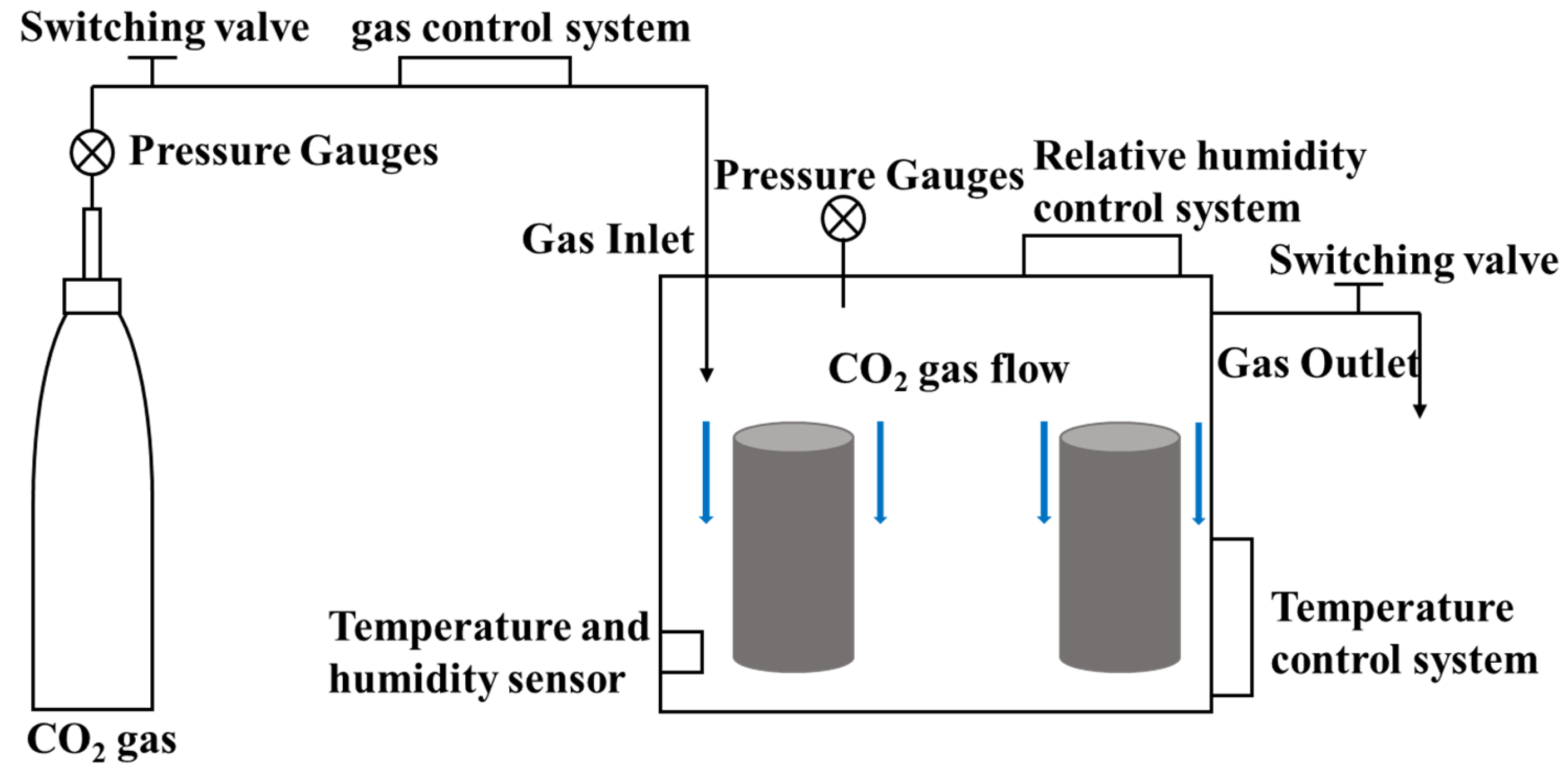
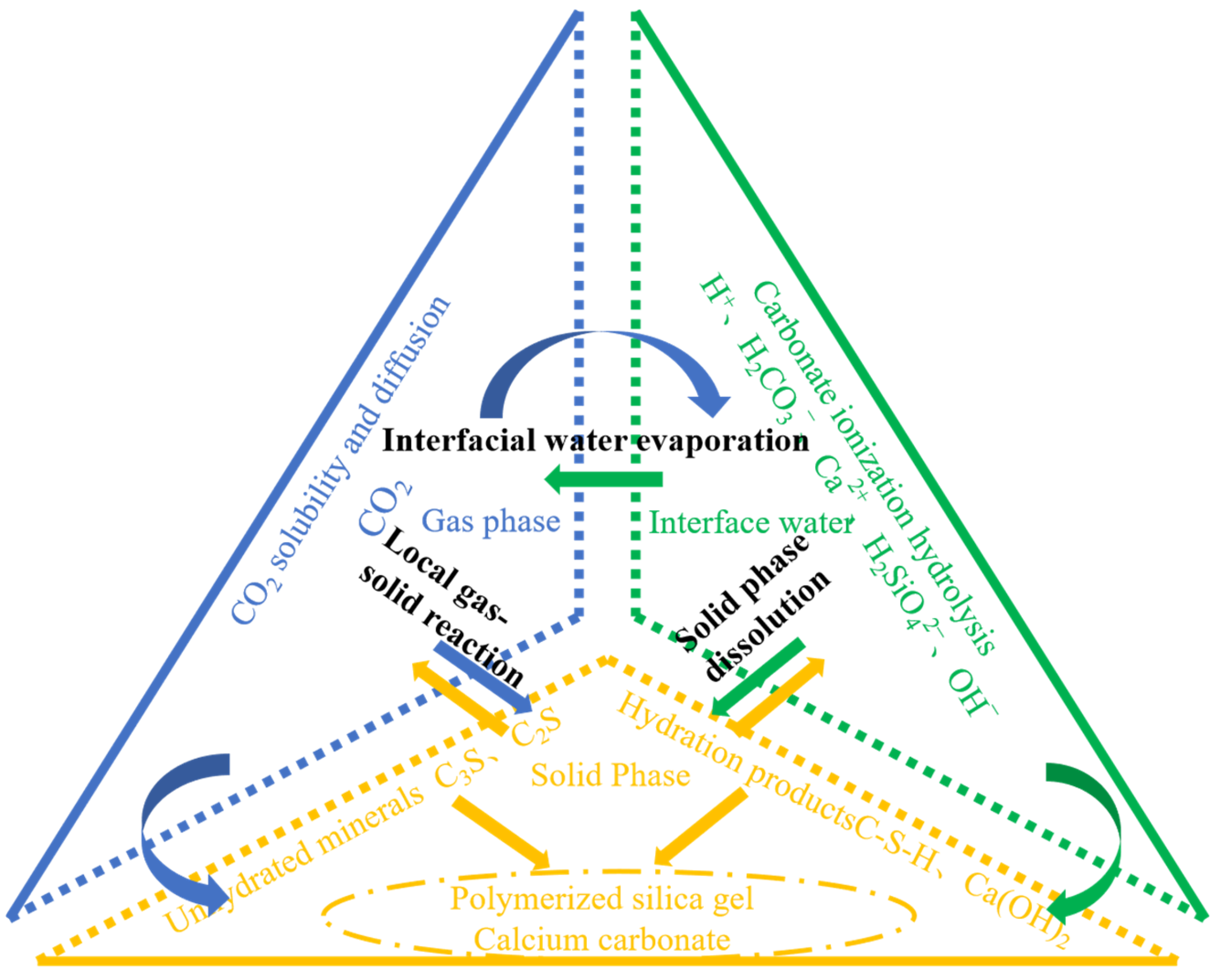
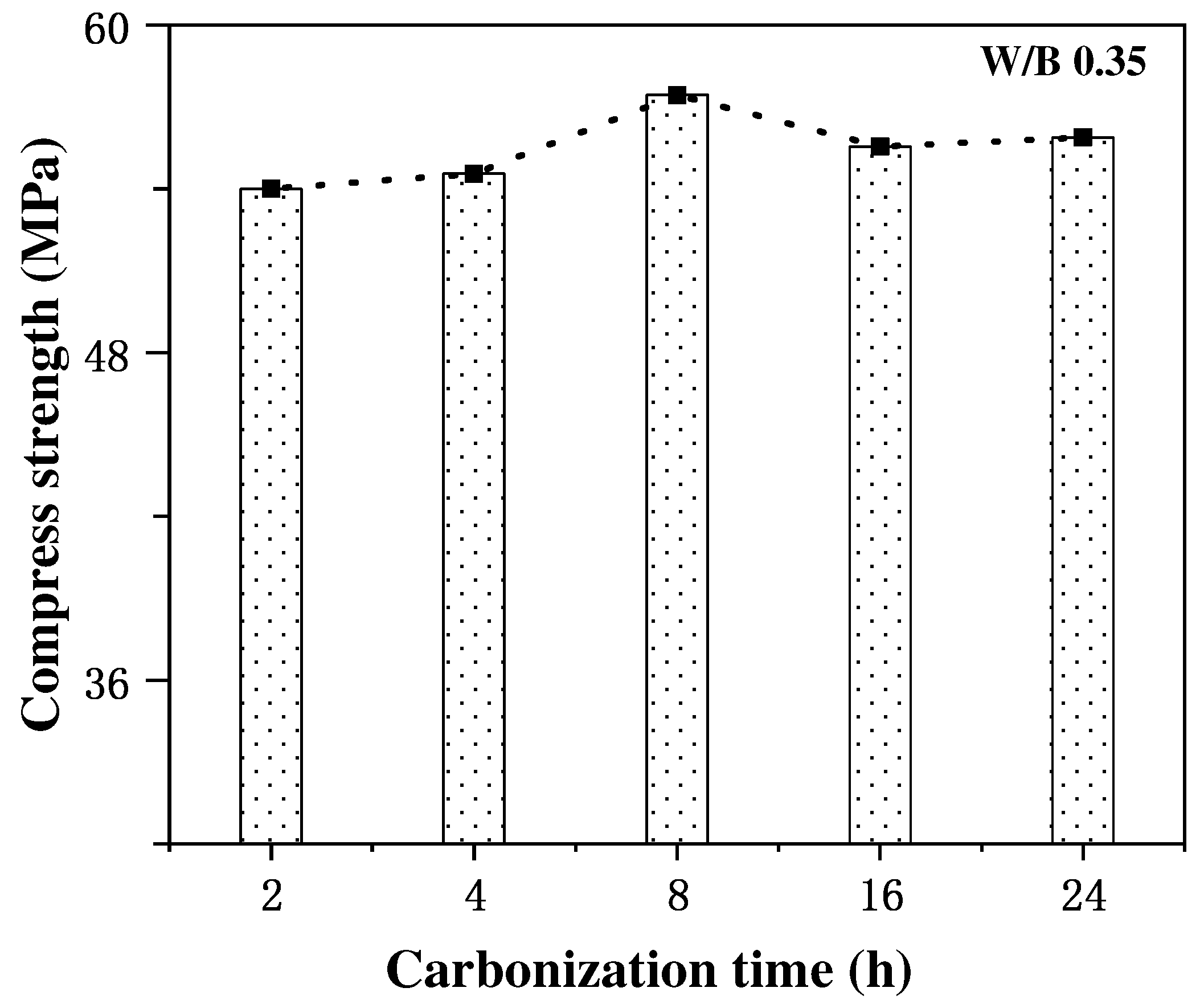

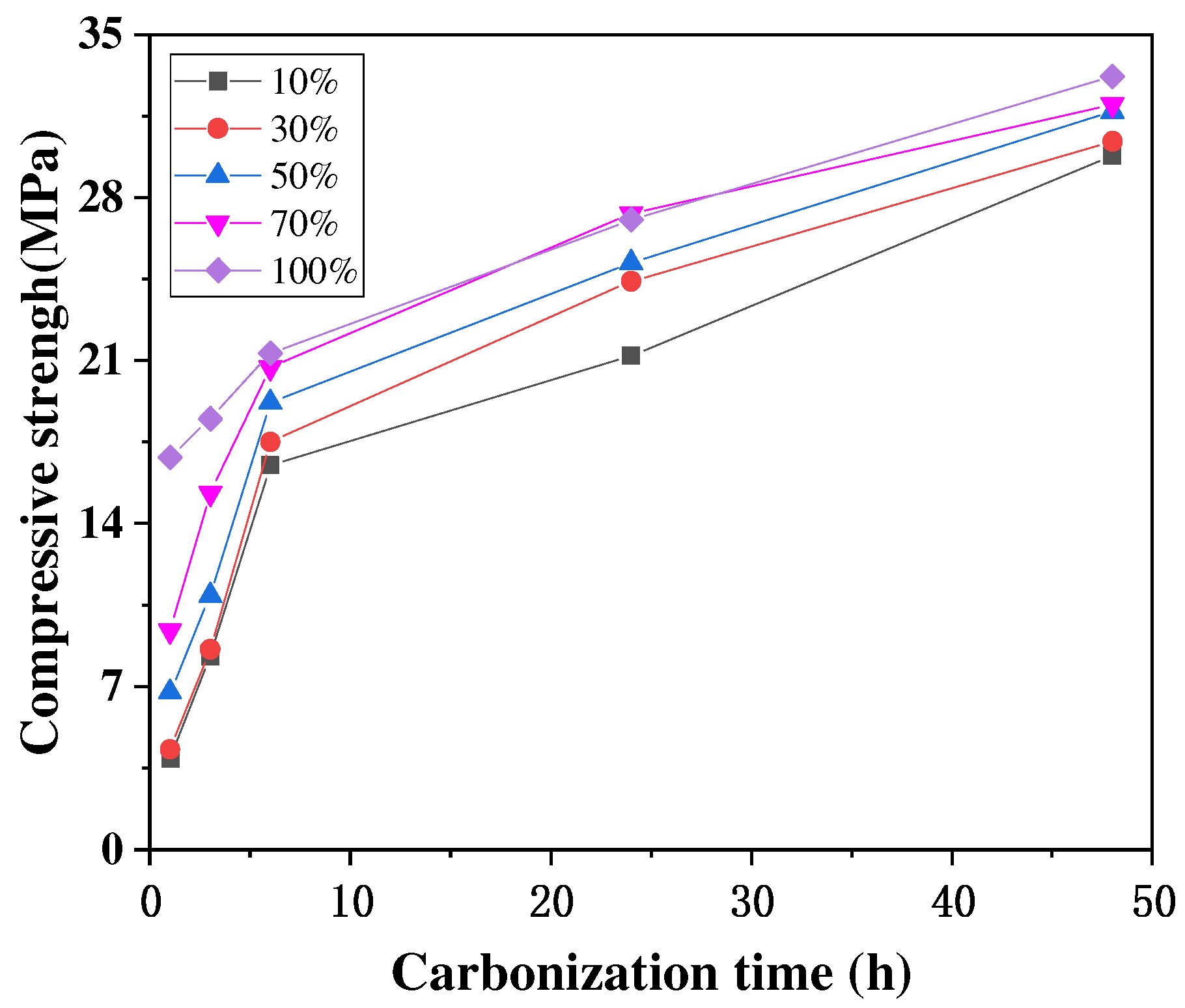
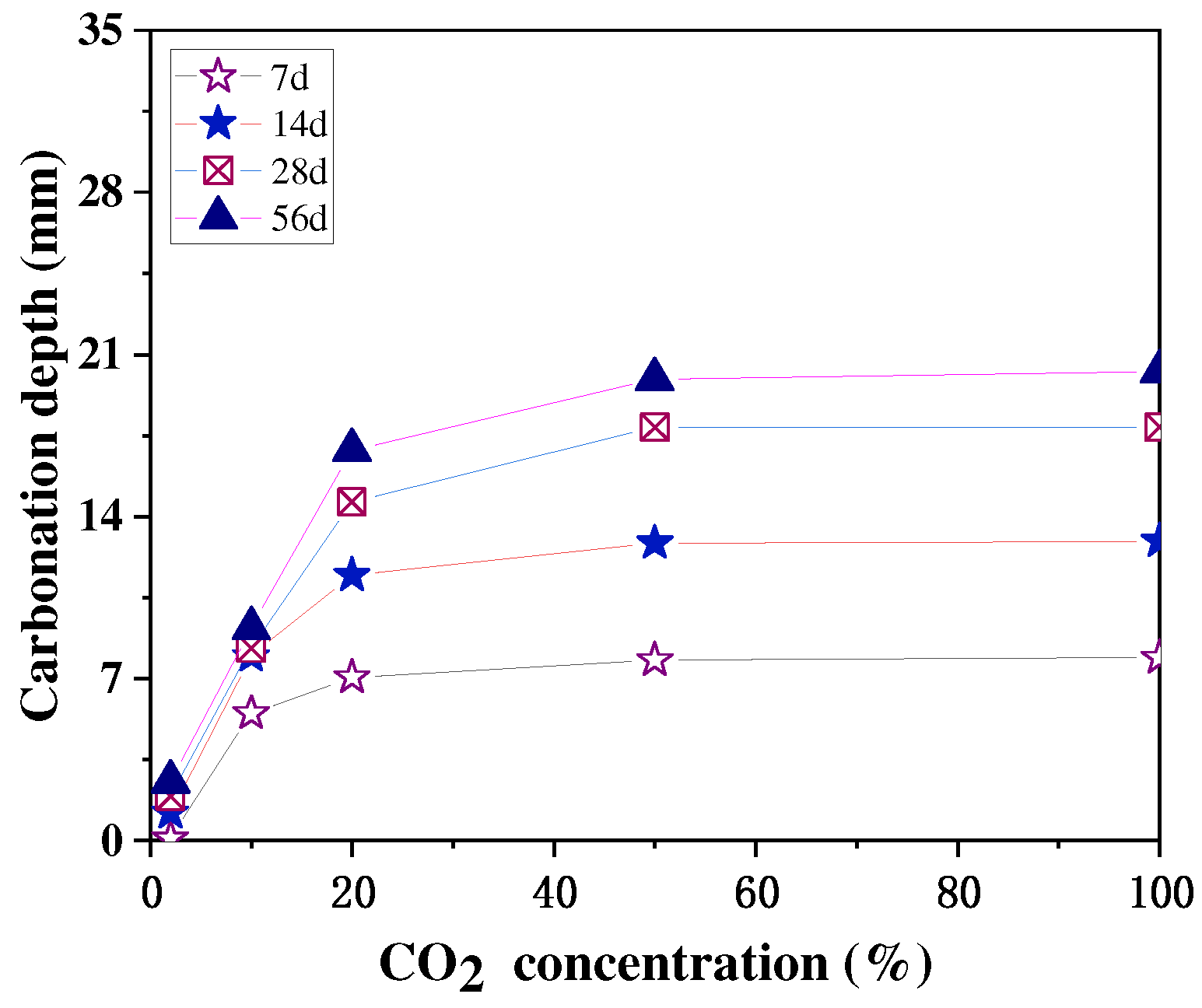
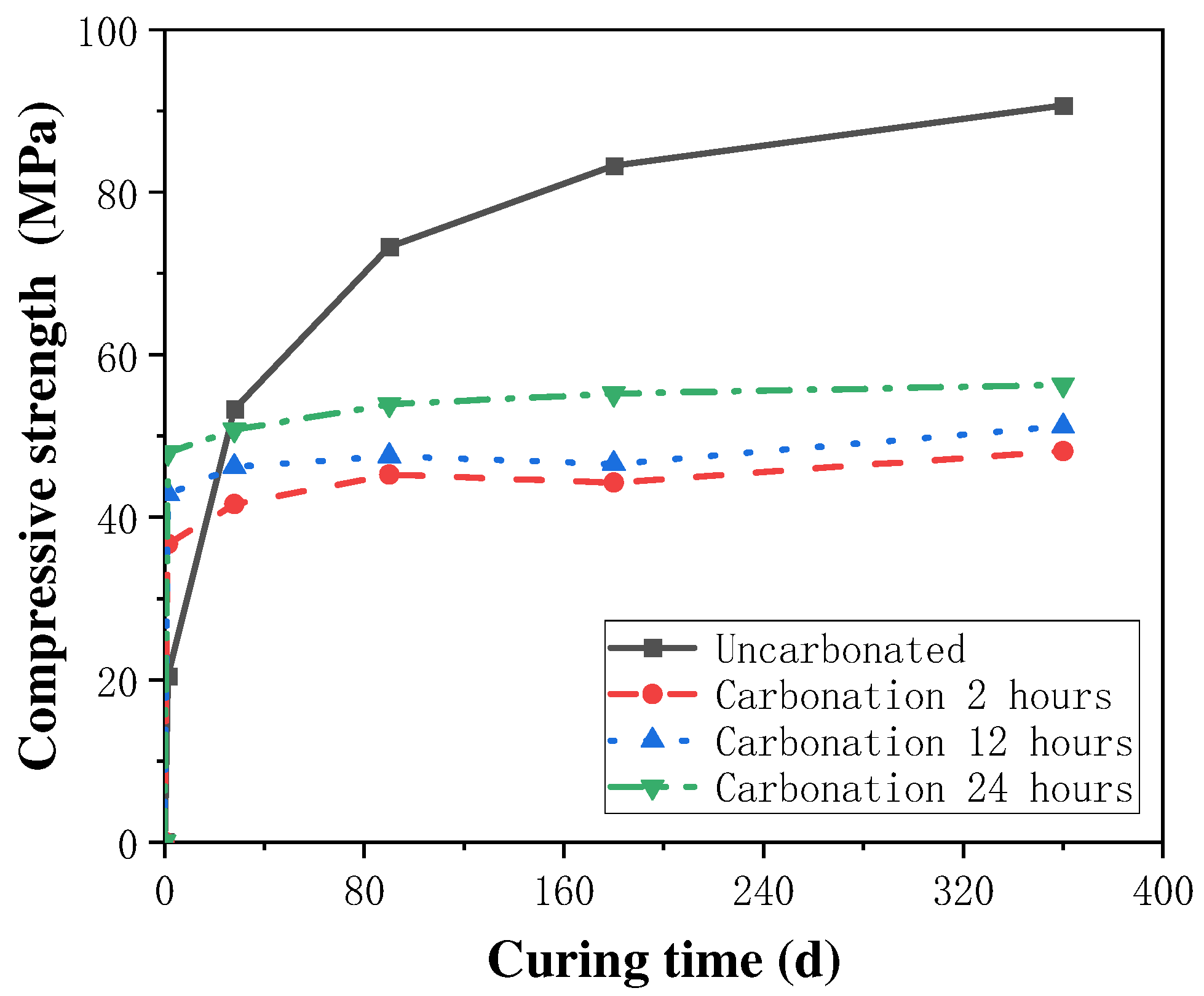


| Carbonation Time (h) | Durability Index | Improvement | References |
|---|---|---|---|
| 2 | Frost resistance | +55% | [27] |
| 12 | Surface resistivity | +608% | [76] |
| Resistance to chloride ion attack | +34% | ||
| 6 | Water absorption rate | −66.5% | [29] |
| Resistance to chloride ion attack | +42.7% | ||
| 12 | Porosity | −2% | [75] |
| Surface resistivity | +734% | ||
| Resistance to chloride ion attack | +53.8% |
| Methods | Compressive Strength (MPa) | Electric Flux (C) | Surface Resistivity (kΩ cm) | Mass Loss Rate of Freeze–Thaw Cycles (%) | Permeability (s) | |||
|---|---|---|---|---|---|---|---|---|
| 20h | 28d | 2d | 28d | 10% | 20% | |||
| Steam Curing | 26.5 | 36.8 | 9861 | 6028 | 13.4 | 16.4 | 67.7 | 61 |
| Carbonation Curing | 23.3 | 38.9 | 2898 | 965 | 42.7 | 0.3 | 8.6 | 391 |
| Standard Curing | 17.0 | 22.1 | 4386 | 1321 | 41.3 | 6.5 | 19.2 | 155 |
| Carbonation Conditions | Apparent Density (kg·m−3) | Water Absorption (%) | Crushing Value (%) | Reference | |||
|---|---|---|---|---|---|---|---|
| Before | After | Before | After | Before | After | ||
| T = 20 ± 2 °C, RH = 60 ± 5%, C = 20 ± 2% | 2.49 | 2.63 | 8.70 | 6.71 | 17.1 | 15.8 | [101] |
| T = 20 ± 2 °C, RH = 55 ± 5%, C = 20 ± 2% | 2.24 | 2.36 | 6.47 | 4.75 | 24.5 | 18.7 | [102] |
| T = 70 ± 5 °C, RH = 50 ± 5%, C = 20 ± 2% | 2.57 | 2.59 | 8.90 | 6.80 | 15.2 | 9.70 | [103] |
| T = 25 ± 3 °C, RH = 50 ± 2%, C = 20% | 2.63 | 2.64 | 5.98 | 4.88 | 13.9 | 11.10 | [104] |
| T = 30 °C, MC = 1.81%, C = 99.9% | 2.62 | 2.65 | 4.34 | 3.20 | 9.27 | 7.19 | [105] |
| C = 99.9% | 2.67 | 2.69 | 4.80 | 3.20 | 16.30 | 15.30 | [106] |
| C = 95% | 2.52 | 2.55 | 4.40 | 3.20 | 17.4 | 12.4 | [107] |
Disclaimer/Publisher’s Note: The statements, opinions and data contained in all publications are solely those of the individual author(s) and contributor(s) and not of MDPI and/or the editor(s). MDPI and/or the editor(s) disclaim responsibility for any injury to people or property resulting from any ideas, methods, instructions or products referred to in the content. |
© 2023 by the authors. Licensee MDPI, Basel, Switzerland. This article is an open access article distributed under the terms and conditions of the Creative Commons Attribution (CC BY) license (https://creativecommons.org/licenses/by/4.0/).
Share and Cite
Zhang, L.; Zha, X.; Ning, J.; Li, W. Research Status on the Application Technology of Early Age Carbon Dioxide Curing. Buildings 2023, 13, 957. https://doi.org/10.3390/buildings13040957
Zhang L, Zha X, Ning J, Li W. Research Status on the Application Technology of Early Age Carbon Dioxide Curing. Buildings. 2023; 13(4):957. https://doi.org/10.3390/buildings13040957
Chicago/Turabian StyleZhang, Lei, Xiaoxiong Zha, Jiaqian Ning, and Wentao Li. 2023. "Research Status on the Application Technology of Early Age Carbon Dioxide Curing" Buildings 13, no. 4: 957. https://doi.org/10.3390/buildings13040957
APA StyleZhang, L., Zha, X., Ning, J., & Li, W. (2023). Research Status on the Application Technology of Early Age Carbon Dioxide Curing. Buildings, 13(4), 957. https://doi.org/10.3390/buildings13040957











